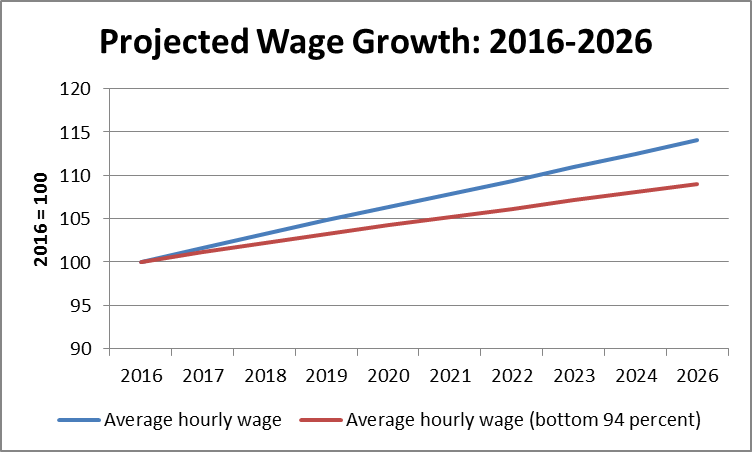October 14, 2016
The reason for asking is that the Congressional Budget Office (CBO) has recently put out some very pessimistic projections for Social Security. These projections got some attention from the media because they were considerably more pessimistic than the projections from the Social Security Trustees, implying a somewhat larger gap between projected benefit payments and projected revenue.
While most of the attention was on the differences in the program’s finances, what actually would mean more to most people is the difference in projected wage growth between the two programs. The CBO projections show a considerably slower path of wage growth than the Social Security trustees projections.
The main reason for this difference is that CBO projects that wage income will be further redistributed upward over the next decade, while the trustees project a small reversal of some of the upward redistribution of the last three decades. While the share of wage income that went over the taxable cap (currently $118,500) was just 10 percent in 1980, this had risen to 18 percent by 2015. This is one of the main reasons that Social Security’s finances look worse now than had been projected three decades ago.
CBO projects that the share of wage income going to those earning above the cap (@ 6.0 percent of workers) will increase to more than 22 percent by 2026. This worsens the finances of the program, since it is not collected taxes on this money, but more importantly it means that most workers will see little wage growth over the next decade. The figure below shows average real wage growth projected by CBO for the next decade (Figure 2-9 from the Budget and Economic Outlook) and the average for the bottom 94 percent of wage earners.
 Source: Congressional Budget Office and author’s calculations.
Source: Congressional Budget Office and author’s calculations.
The CBO projections imply that real wages will rise by an average of 9.0 percent over the next decade for bottom 94 percent of workers. The upward redistribution projected by CBO would cost the typical worker just over 4.4 percent of their wages. This means that for a worker who would otherwise be earning $50,000 in 2026 (in 2016 dollars), the upward redistribution projected by CBO will mean a loss of wages of $2,200, so that they would only be earning $47,800.
As a practical matter, most workers are likely to do considerably worse under the CBO scenario. If past trends continue, the workers closer to the taxable cap (e.g. the 90th percentile worker) are likely to see somewhat higher wage growth than workers near the middle and bottom of the wage distribution. In other words, the CBO projections imply that most workers will see little or no wage growth over the next decade as the overwhelming majority of wage gains go to those at the top of the income distribution.
This should be of great concern to Hillary Clinton since she has committed herself to pushing through an agenda that ensures most workers share in the benefits of wage growth. The CBO projections imply that this is clearly not the case and the projected upward redistribution of income will matter much more to workers’ living standards than any conceivable increase in Social Security taxes — even if the media will do their best to ensure that the public only hears about the taxes.







Comments